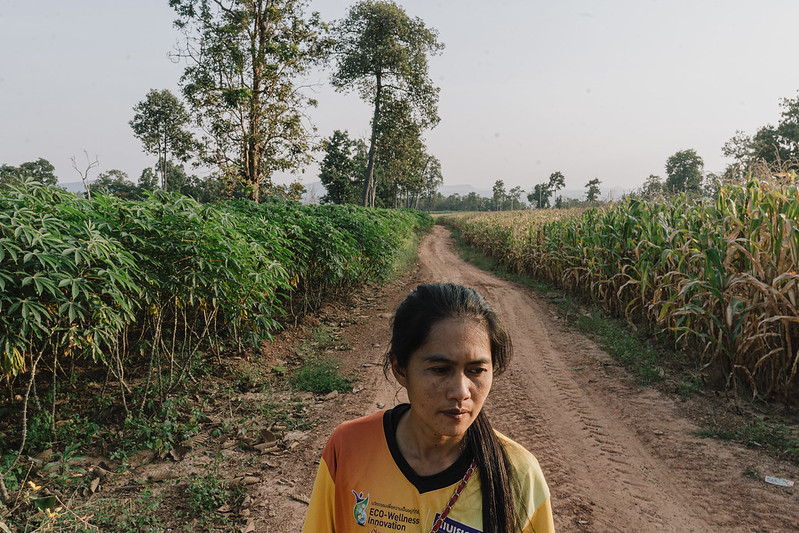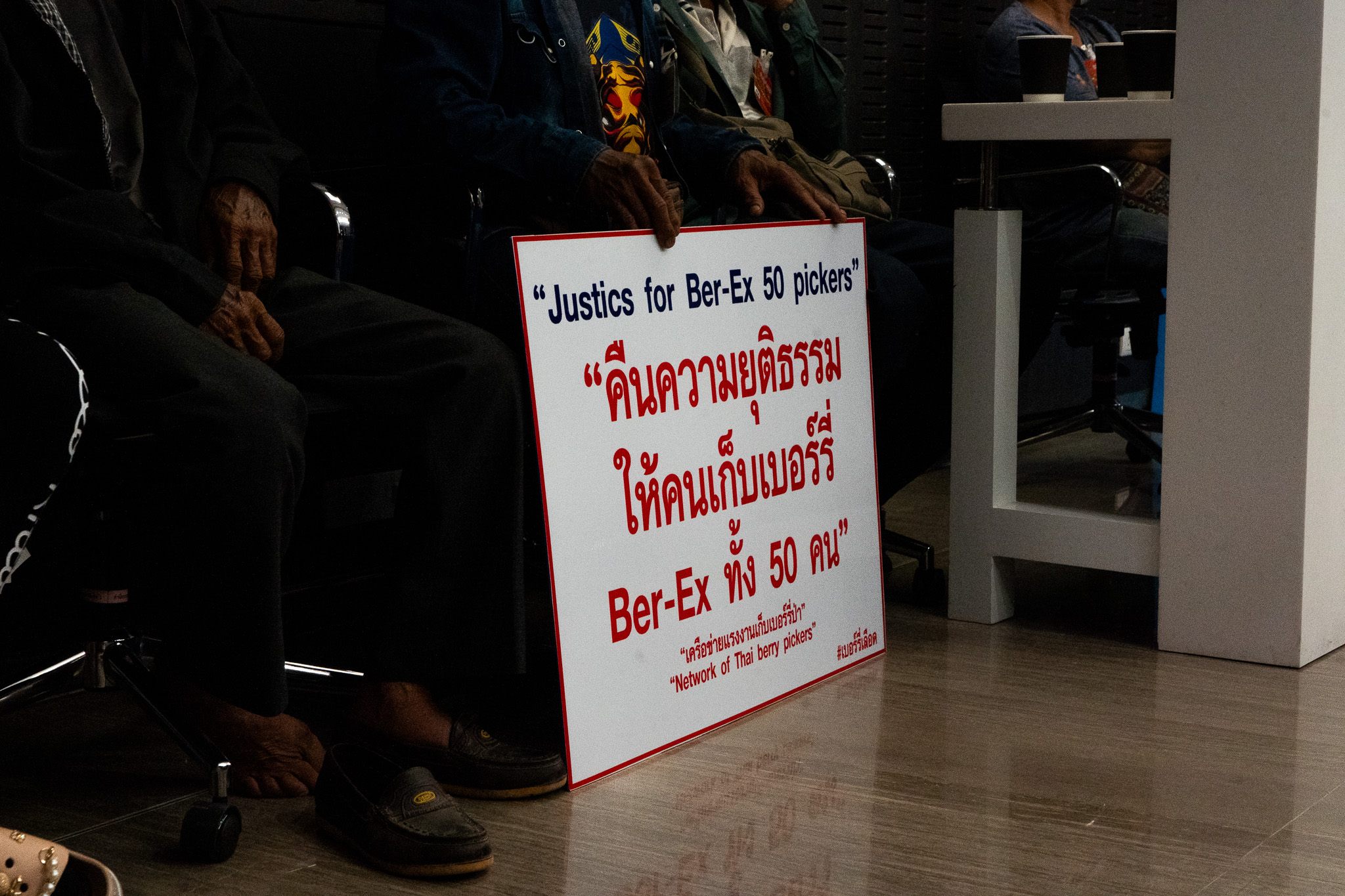
Luk thung-molam songs penned by independent and previously unknown Isaan singers are racking up millions of views on YouTube. Cover versions released by fellow artists, both amateur and professional, have helped bring these artists much popularity and national fame in recent years.
How did this new generation of Isaan singers gain such massive success in Thailand’s mainstream music culture? What makes them different from the old guard of Isaan artists who helped popularize the genre?
The Isaan Record’s Yodsapon Kerdviboon talked to Panis Phosriwungchai, a graduate student from Chulalongkorn University’s Faculty of Communication Arts who studied the evolution luk thung-molam music.

Panis Phosriwungchai, is a graduate student from Chulalongkorn University’s Faculty of Communication Arts and an editor for The101.World. Photo by Methichai Teaona.
A new generation on the rise
About 15 to 20 years ago, Thailand’s music scene saw the rise of Isaan luk thung molam artists like Mike Phiromphon, Jintara Poonlarp, Sunai Ratchasima and Noknoi Uraiporn.
Their songs were folk pop songs telling the stories of Isaan people trying to escape the hardship of rural poverty through labor migration to Bangkok. Their goal was to earn money and have a better future free of the misery caused by failing rice crops and low agricultural prices back home. Notable examples are Tai Orathai’s “Dok Ya Nai Pa Poon” (A Grass Flower in the Concrete Jungle) or the songs of working class hero Mike Piromporn that dealt with the experience of Isaan migrant workers in the capital.
“In the music video for Dok Ya Nai Pa Poon, there is a portrayal of an Isaan girl who comes to Bangkok with little luggage and doesn’t even know how to cross the street,” Panis says. “Mike Piromporn’s music also features representations of laborers who came to Bangkok to chase their dreams. This was Isaan luk thung music 10 to 20 years ago.”

Tai Orathai’s music video for the song “Dok Ya Nai Pa Poon” (Grass Flower in the Concrete Jungle) reflects the lives of Isaan people who left their villages to look for work in Bangkok.
But in the past six years, Panis has noticed a change in the genre with the emergence of a new breed of artists like Kong Huayrai, Zak Chumpae and Lamyai Haithongkam.
“These artists are Isaan’s new generation. They grew up in the region that is now more developed,” Panis says. “The Isaan way of life today is not [as much] defined by hardship and poverty like in the past, so the lyrics of the Isaan luk thung music nowadays have changed.”
The lyrics of the genre that Panis calls “Isaan luk thung pop” have shifted their focus and deal less with Isaan people’s life in Bangkok.
“The lyrics are not as sad, or even if they are, they are in a fun way,” Panis notes. “The songs talk about the lives of the Isaan people in the countryside. In some songs, the lyrics reflect the pride of being from rural Isaan.”
“In ‘Oh La No’ by Kong Huayrai, the lyrics go ‘take your blood sample, it’d show Lao through and through’,” Panis says. “The songs also tell you that being Isaan-born means going to village festivals with molam gigs, eating lap, raw meat, still remembering the country way of life. It’s a recital of their own culture with a degree of pride.”

The song “Ho Mok Huak Pai Fak Pa” (Bring the Steamed Tadpoles to Auntie) by Lam Ploen Wongsakorn and Tae Trakooltor portrays the life in rural Isaan in a humorous and positive way.

Music video for “Oh La No” by Kong Huayrai portrays the lives of Isaan people with humor and pride.
Apart from a new focus in the lyrics, the composition and instruments have also changed. Older songs of the genre and molam klon used mainly traditional Isaan instruments like the khaen, phin, and flute. But present-day Isaan music also includes the sound of guitars, violins, and pianos, adding a more modern flavor.
For example, the song, “Phu Sao Ka Lo” (The Girl Gets Around) by Lamyai Haithongkam is about a teenage girl who has a crush on a boy. The music is more modern and it uses different instruments, not only the phin and a flute.
A power shift in media production
Panis argues that widespread access to the internet and the popularity of online platforms has had a major impact on current Isaan luk thung molam music. It has turned upside down established music distribution channels and provided artists with the means to easily reach out to a wider audience.
Some people argue that the genre’s popularity is simply a numbers game. The success of luk thung molam songs is explained by the large number of Isaan people who make up about a third of the country’s population.
But Panis found in her study on popular Isaan music that the music’s success has, with the arrival of online media, had a lot to do with the shift in the power to produce and distribute songs.

Kong Hauyrai recorded his music on a mobile phone and posted it on Facebook before he became famous.
In the past, when Isaan artists strove to become famous, they had to go through the music labels in Bangkok or major Isaan cities who functioned as gatekeepers.
“They don’t need to do that anymore. If they want to be a famous singer, they can record the music at home and post it online without having to travel to Bangkok to find a music label,” Panis says.
She believes that the less that Isaan artists’ fates were at the whims of record labels and their financial support, the more unique and authentic the lyrics and music they produced. This has led to more lyrics being sung in Isaan-Lao.
“Some songs are completely sung in Isaan, and people in the central region or other regions might not even get the lyrics.”
This phenomenon has given a new freshness to the luk thung molam genre and the music industry. Artists have become more daring to try out new things and to experiment with new styles.
This freshness, combined with the power of media dissemination bestowed by the internet, allows the Isaan sound to travel faster, and, in turn, when the mainstream media picks up the songs, they get pushed out into an even wider audience.
“We can see that music contest shows or soap operas on television bring Isaan artists to perform during prime-time hours when there is high audience exposure, which brings the once marginalized to the center stage,” Panis says.

“Ku Khong,” written by Kong Hauyrai, became the theme song for the television soap opera Naki which aired on Channel 3 in 2016.

Internet stars Lam Ploen Wongsakorn (third from left) and Tae Trakooltor (left) perform “Ho Mok Huak Pai Fak Pa” on national television.
New perspectives for Isaan artists
One explanation for the evolution of the genre is simply that life in Isaan has been changing, Panis argues. The difference between what’s rural and what’s urban has never been more blurred. Isaan people have become more mobile and at the same time they have been exposed to more outside influences through more diverse media consumption.
“If you live in the middle of a rice farm, you can now watch Premier League matches at the same time when others are watching it in a Bangkok shopping mall beer garden,” she points out. “This kind of media consumption erases the rural element and expands the Isaan people’s perspective and knowledge.”
Their broadened perspective and access to diverse forms of media has enabled Isaan artists to produce more diverse songs and fuse different styles.
“We can see that Isaan songs nowadays make use of R&B, rap, and soul music,” Panis says. “For example, Rasmee Isan Soul’s lyrics use Khmer and Isaan to the sound of soul music.”
Audiences have also grown used to listening to a greater variety of music. Contemporary artists of the region are answering to that demand and have found the courage to go beyond the roots of traditional Isaan culture and constantly incorporate new styles.
A pride of being from Isaan
Emerging from the rise of this new Isaan music is a novel sense of pride in being from Isaan that rejects decades of discrimination and ridicule.
Panis observes, “It’s like Isaan people are saying: ‘We are Isaan people. We are Lao. We are from this region and we are talented and brilliant,’” At the same time, she says, these artists are open to mix their local and regional identity with influences from other cultures like Western music or other forms.
Comparing the new generation to the artists that came before them, Panis has also noticed a different outlook on the world and life in general. Previous generations still struggled with a sense of inferiority and the perception that they are forever barred from having a good life. But younger Isaan people don’t seem to share this attitude anymore.
“They are not just Isaan people or Thai, but global citizens,” Panis says. “For them, the world is connected and has no borders, a sentiment that Isaan pop reflects so clearly.”





